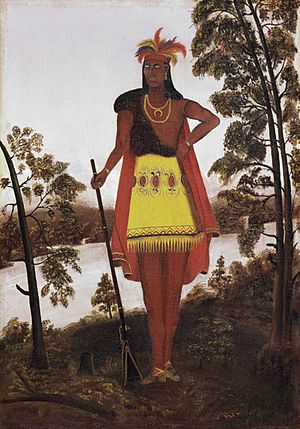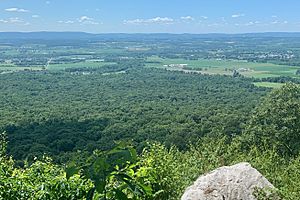Shikellamy facts for kids
Quick facts for kids
Shikellamy
|
|
|---|---|

1820 painting by an anonymous artist
|
|
| Born | c. 1680 |
| Died | December 6, 1748 |
| Occupation | Oneida chief |
| Children | Logan, Tachnechtoris, "The Spreaking Oak" AKA John Skikellamy or Captain Logan, Second son Tah-gah-jute or Sayughtowa AKA James Logan, third son Arahhot or "Unhappy Jake", 4th son John Petty or Sagogeghyata, daughter widow of Cajadies |
Shikellamy (born around 1680 – died December 6, 1748), also known as Shickellamy or Swatana, was an important Oneida chief. He worked as a supervisor for the Iroquois Confederacy, a powerful group of Native American nations. In this role, Shikellamy helped oversee the Shawnee and Lenape tribes in central Pennsylvania. He also helped protect the southern border of the Iroquois lands.
Shikellamy first appeared in historical records in 1728 in Philadelphia. At that time, he lived in a Shawnee village near what is now Milton. In 1742, he moved to the village of Shamokin, which is now Sunbury. This village was located where the West and North Branches of the Susquehanna River meet. Shikellamy was a key person in the early history of Pennsylvania. He acted as a go-between for the colonial government in Philadelphia and the Iroquois chiefs in Onondaga. He welcomed Conrad Weiser, a famous diplomat, to Shamokin. Shikellamy also guided Weiser on his trips into the wild areas of Pennsylvania and New York.
Contents
Shikellamy: A Diplomat for the Iroquois
We don't know exactly when or where Shikellamy was born. His first recorded visit to Philadelphia, the capital of Pennsylvania, was in 1728. The Quaker leaders in Philadelphia quickly saw that Shikellamy was an important Native American leader. They invited him back to the capital in 1729. People described him as "a trusty good Man & great Lover of the English."
The Pennsylvania government asked Shikellamy to invite the Iroquois Confederacy leaders to a meeting in 1732. This first meeting was successful, and both sides agreed to meet again. These important meetings were set up by Shikellamy and Conrad Weiser.
Shikellamy, Weiser, and the Pennsylvanians worked together on a treaty in Philadelphia in 1736. Through this agreement, the Iroquois sold land near the Delaware River and south of the Blue Mountain. This was a big change in Pennsylvania's approach to Native Americans. Before this, William Penn had not taken sides in arguments between tribes. But by buying this land, the Pennsylvanians were favoring the Iroquois over the Lenape. This policy helped the Iroquois stay allied with the British, which was important during conflicts like the French and Indian Wars.
A Friend to Christian Missionaries
Shikellamy first lived in a Shawnee village near modern Milton. The Shawnee moved west by 1742. In that year, Shikellamy moved to Shamokin village. This was an important Lenape town and home to Sassoonan, a Lenape leader.
The colonial government of Pennsylvania rewarded Shikellamy for his help with treaties. In 1744, Conrad Weiser oversaw the building of a house for Shikellamy in Shamokin. The house was about 49.5 feet (15.1 meters) long and 17.5 feet (5.3 meters) wide, with a shingle roof.
Shikellamy's important position in Shamokin made him a key person for Moravian missionaries. These missionaries wanted to share the gospel with Native Americans in Pennsylvania. Count Zinzendorf, a bishop from the Moravian Church, visited Shikellamy in 1742. The Count believed that Shikellamy, who had become a Christian, could help convert other Native Americans.
Shikellamy allowed the Moravians to have a base in Shamokin. He also served as a link between the Moravians and other Native American villages. Shikellamy let the Moravians stay in Shamokin because he believed they truly cared about Native Americans. He knew that, unlike some other white men, the Moravians did not want their furs or their land. They also did not give alcohol to his people. Shikellamy admired the Moravians so much that he let them stay in his home. He also lent them horses and helped them build their homes.
Shikellamy formally became a Christian in November 1748 in the Moravian city of Bethlehem. On his way back home, Shikellamy became ill. Despite the help of his Moravian friends in Shamokin, he passed away on December 6, 1748.
Shikellamy's Family
Historians generally agree that Shikellamy had four or five sons and at least one daughter.
- His oldest son was Tachnechtoris, also known as "The Spreading Oak" or John Shikellamy. White settlers called him Captain Logan.
- His second son was Tah-gah-jute or Sayughtowa, better known as James Logan. He was named after James Logan, an important Quaker leader in Pennsylvania.
- Another son was Arahhot, possibly "Unhappy Jake," who died in a war in 1744.
- His youngest son was John Petty or Sogogeghyata, named after a trader.
- Shikellamy also had a daughter, who was the widow of Cajadies, a famous hunter.
- Shikellamy's wife was named Neanoma, a Cayuga woman. Their children were considered Cayuga, following Native American tradition.
After Shikellamy's death, his son John Shikellamy (also known as John Logan) became chief. Another of Shikellamy's sons, James Logan, became very famous in American history as "Chief Logan". He played a big part in Dunmore's War in 1774 and gave a well-known speech called "Logan's Lament."
Legacy
Shikellamy's name is still very important in Northumberland County today.
- Shikellamy State Park is named after him.
- Shikellamy High School and Chief Shikellamy Elementary School also carry his name.
- The Shikellamy School District, which runs these schools, was named after him in 1964.
- In Berks County, there was a Boy Scout camp called Shikellamy Scout Reservation, which closed in 1978.
- Above that camp, there is a rock viewpoint called Shikellamy Summit along the Appalachian Trail.



